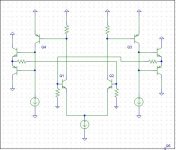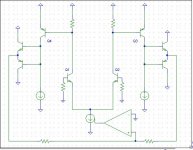Okay, attached are two fully differential (with differential outputs) amplifiers. They are drawn VERY basic, with the main different being the feedback network.
==> One of the amps uses the basic crossover feedback (feed the output of one side back to the input of the other for symmetry). No attention to common mode voltage at the output is paid in this one. I have included this one to illustrate the "conventional" way I would think to apply feedback to a fully differential amp.
==> The other (attached as a reply to this first thread) uses a resistor divider average along with an opamp to adjust the input stage tail supply for the bias point (this method is used in some fully differential opamps in the analog integrated circuit field, but I haven't seen it used in a discrete fully differential amp). Will this method work for getting all the bias points to "settle down" in the entire amp (such as a 0V operating point at both outputs for maximum voltage swing)? To me, it looks like this method would be a simple integrator (sometimes used in a single ended amp to tightly control offset at the output) that is fed by the average of the two outputs as its input.
==> One of the amps uses the basic crossover feedback (feed the output of one side back to the input of the other for symmetry). No attention to common mode voltage at the output is paid in this one. I have included this one to illustrate the "conventional" way I would think to apply feedback to a fully differential amp.
==> The other (attached as a reply to this first thread) uses a resistor divider average along with an opamp to adjust the input stage tail supply for the bias point (this method is used in some fully differential opamps in the analog integrated circuit field, but I haven't seen it used in a discrete fully differential amp). Will this method work for getting all the bias points to "settle down" in the entire amp (such as a 0V operating point at both outputs for maximum voltage swing)? To me, it looks like this method would be a simple integrator (sometimes used in a single ended amp to tightly control offset at the output) that is fed by the average of the two outputs as its input.
Attachments
- Status
- This old topic is closed. If you want to reopen this topic, contact a moderator using the "Report Post" button.

